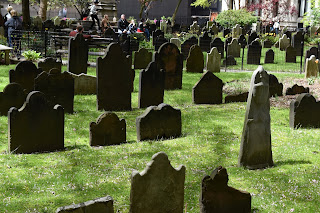Trinity Episcopal Church in Manhattan is a good place to think about transience. Here's the grave of publisher William Bradford, appointed Royal Printer to the New York Colony in 1693, who founded New York's first newspaper but whose tombstone is covered with words now decayed into near illegibility. Other gravestones stand witness to the human desire to leave behind an enduring mark, but time and the elements erase the words until the stones stand silent.
These crumbling gravestones are surrounded by new attempts to leave a mark, construction cranes rising to the sky and new buildings cropping up to cover all trace of what preceded them. A few blocks away the Oculus looks like a child's toy about to take flight and somehow manages to be bigger on the inside than on the outside, while the 9/11 memorial presents viewers with a dark abyss evoking absence and inconsolable loss, but we spoke to parents of some 9/11 victims who shared their enduring hope and resilience.
Around the 9/11 memorial plaza, glass buildings reflect each other in the early-morning sun, creating images that looked first solid and then fluid, like watercolors that could be wiped away with one sweep of an artist's hand. We will always keep creating things to mark our space and we will always be losing things we thought would last forever, but somewhere in that cycle of creation and destruction we manage to make a place for hope.
 |
| Oculus. |
 |
| Freedom tower through the trees. |
 |
| 9/11 memorial |
 |
| Reflections. |
 |
| William Bradford's gravestone. |
 |
| Old meets new. |
 |
| Trinity churchyard. |
 |
| Alex and Eliza. |



No comments:
Post a Comment